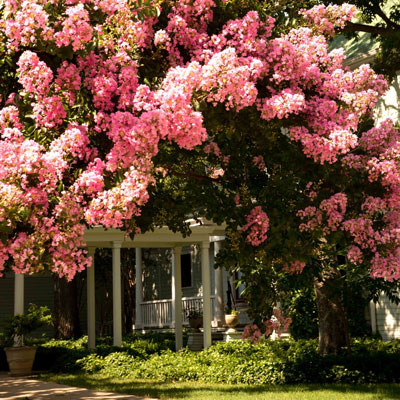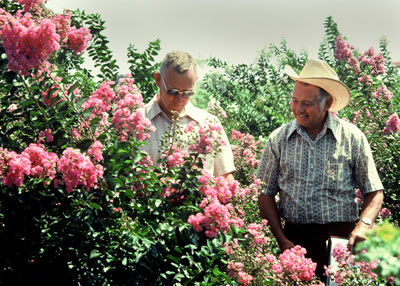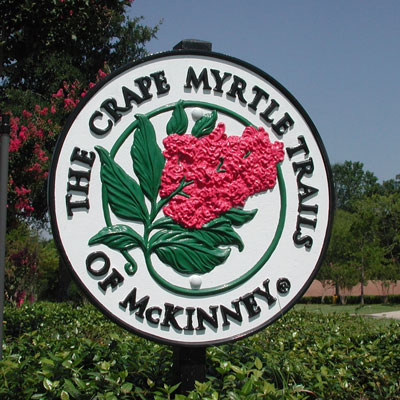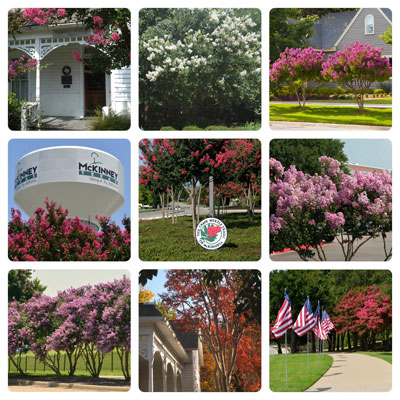Success With Crape Myrtles
I’ve been an advocate for crape myrtles all of my life. When I was a young horticulturist-in-training as a teenager in College Station, they were all grown as large shrubs. Then, in the late 1950s, landscapers began to remove lower branches and convert them into small accent trees. Their trunks, after all, are some of the prettiest of all our trees in Texas.

This photo from one of McKinney’s older neighborhoods, speaks to the longtime popularity of crape myrtles.
The first dwarf crape myrtles that I saw were introduced by Monrovia Nursery Company in 1960. They were labeled as the “Petite” series, and they were sold in all traditional crape myrtle colors – red, deep red, pink, white, lavender and purple. Those Petites remain some of my favorites.
By the mid-1960s, Dr. Donald Egolf of the U.S. National Arboretum in Washington D.C. began his heroic work with crape myrtles. He was seeking genetic protoplasm that would bring resistance to powdery mildew into the family. Using a virtually unknown species, Lagerstroemia fauriei, Don planted some 200,000 seedlings for trial. If they showed any hint of mildew, they were plowed under. By the time his research was finished several years after his untimely death in the early 1990s, Don had introduced 29 varieties, each assigned an Indian tribal name in honor of his native home state of Oklahoma. Catawba (rich purple – my favorite to this day) was first, and Arapaho (gorgeous red), I believe, was the final one.

Dr. Don Egolf of the National Arboretum evaluates crape myrtles in 1975 with Benny Simpson at TAMU Dallas. I took this photo, and it is a highlight of my years working for Texas A&M.
In 1998 we began work on The Crape Myrtle Trails of McKinney. Our goal has been to establish McKinney as the place to go to see crape myrtles. Much of our work has been patterned after the wonderful legacy of the Tyler Azalea Trails. We are grateful for their advice and support early in our effort.

You’ll know you’re in the official portion of The Crape Myrtle Trails of McKinney when you see these signs.
So all of that sets me up to give you my suggestions on the best ways to succeed with these wonderful plants. I’ll list my ideas as bullets just to keep this from turning into a book.
Guidelines to Crape Myrtle Happiness!
• Buy a variety of the color and height that matches your needs and space available. Here is our list of the best types from the Crape Myrtle Trails website.
• Plant in full sun and where the plant can grow to its full, mature size without having to prune to reduce its height or spread.
• Water freely and apply an all-nitrogen fertilizer to maximize growth.
• If you’re training a crape myrtle to grow tree-form, gradually remove lower branches. You can do so at any time of the year.
• Never “top” a crape myrtle for any alleged reason. Reducing its size is not an acceptable cause. I’ve given up trying to help people adjust their plants’ heights. I now say, “Either move, or remove it.” In other words, either transplant it to a more spacious spot, or dig it out and discard it entirely.
• If you move into a house where a crape myrtle has been topped, here are instructions on how to salvage it. Read down on this page from our CMT website.
• Aphids may visit your crape myrtles and leave a sticky residue (“honeydew”) behind. If you’re in the DFW area, you may also see crape myrtle scale insects on its twigs and stems. They were first seen in Richardson in 2004, and they are still most heavily concentrated in the Metroplex and eastward. Overall, however, this year is not showing so far to be a bad year for them. Both pests are addressed in this page from the CMT website.

All photos taken in and around McKinney.

Left photo: Brilliant colors of crape myrtle foliage in spring.
Right photo: Brightly colored trunks add winter interest.
